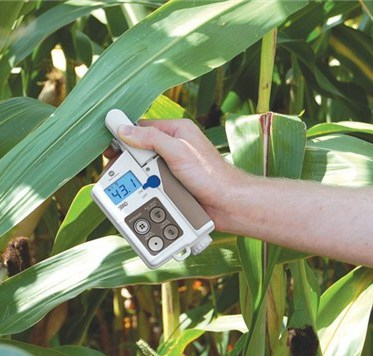Vegetation pigment concentrations are accurately measured by laboratory analysis methods that involve pigment extraction by organic solvents such as methanol, acetone.
Some spectroscopic instruments that measure light absorption in pigment sensitive wavelengths are also available for rapid and reliable chlorophyll surveys. Some examples of such instruments:
- SPAD 502 Plus Chlorophyll Meter: It has been developed by Spectrum Technologies,

source: Spectrum Technologies Inc. It measures ‘greenness’ of leaves based on optical density difference at two wavelengths – 650nm and 940nm. It provides relative chlorophyll content with index value ranging from -9.9 to 199.9
- MC-100 Chlorophyll Concentration Meter: It has been developed by apogee instruments. It provides chlorophyll concentration in
mol of chlorophyll per m2 of leaf area. It can also provide greenness index similar to SPAD.
- atLEAF chlorophyll meter: It has been developed by atLEAF. Similar to SPAD it measures relative chlorophyll content. Species name can be linked with the observations.
- CCM-200plus chlorophyll content meter: It has been developed by OPTI-SCIENCES. It measures relative chlorophyll content.
- Multiplex330: It has been developed ForceA. It calculates anthocyanin and chlorophyll index by measuring blue fluorescence under UV excitation.
- DUALEX SCIENTIFIC: It has been developed by Force-A. It measures chlorophyll concentration (
g per cm2 of leaf area), index of epidermal flavonoids, Nitrogen Balance Index and Index for epidermal anthocyanin.
The chlorophyll meters have been found to be reliable method of measurements in crop nitrogen assessment (leaf chlorophyll is a good indicator of plant nitrogen status). These instruments have also been tested in range of canopies and found to be effective tools chlorophyll assessment. However, it is important to note that the calibration equations used to convert unitless response of these instruments into absolute concentration are developed for narrow range of species and hence may be less suitable for wild vegetation species.
Anthocyanin and flavonoid meters are newly developed and have not been widely tested so far.
References:
Cerovic, Z. G., Masdoumier, G., Ghozlen, N. B. & Latouche, G. A new optical leaf-clip meter for simultaneous non-destructive assessment of leaf chlorophyll and epidermal flavonoids. Physiol. Plant. 146, 251–260 (2012).
Coste, S. et al. Assessing foliar chlorophyll contents with the SPAD-502 chlorophyll meter: a calibration test with thirteen tree species of tropical rainforest in French Guiana. Ann. For. Sci. 67, 607–607 (2010).
